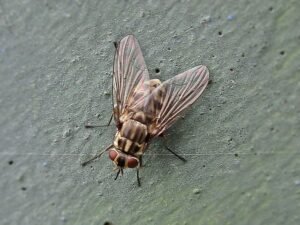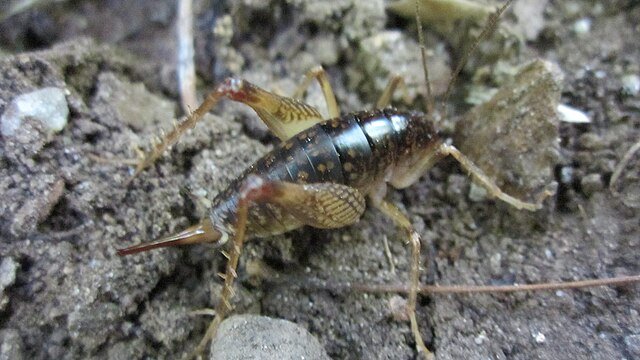Stable Flies (Stomoxys calcitrans): The Painful Biters of Farms and Homes
 If you’ve ever stood near a barn or backyard stable and felt a sharp sting on your legs, chances are you’ve met the stable fly (Stomoxys calcitrans). Unlike most other house flies, stable flies actually bite humans and animals to feed on blood.
If you’ve ever stood near a barn or backyard stable and felt a sharp sting on your legs, chances are you’ve met the stable fly (Stomoxys calcitrans). Unlike most other house flies, stable flies actually bite humans and animals to feed on blood.
As a pest control expert and agronomist, I’ve treated hundreds of farms, dairies, and even beach cafés suffering from stable fly infestations. They look similar to ordinary house flies, but they behave very differently—and they can make life miserable for livestock, pets, and people alike.
In this guide, I’ll explain how to identify them, where they come from, and most importantly, how to break their life cycle with simple and effective control strategies.
Identification of Stable Flies
Stable flies belong to the family Muscidae, the same family as house flies. But their feeding habits and mouthparts set them apart.
Main identification traits:
Size: 6–8 mm (slightly smaller than a house fly).
Color: Grey body with four dark stripes on the thorax.
Distinct feature: A long, needle-like mouthpart (proboscis) projecting forward.
Behavior: They bite humans, cattle, and horses, mainly on the lower legs.
Resting habit: Often rest on walls, fences, or the lower body of animals.
While they look like house flies (Musca domestica), house flies cannot bite—they feed on waste and food residues. Stable flies, on the other hand, pierce the skin to suck blood.
Biology and Ecology
Understanding their biology helps in controlling them effectively.
Feeding behavior: Both males and females feed on blood, usually two times per day.
Egg laying: Females lay eggs in moist, decaying organic matter—especially where manure and hay mix.
Lifecycle: Egg → Larva (maggot) → Pupa → Adult. The cycle can complete in 3–4 weeks, faster in warm weather.
Activity: Most active in warm, humid conditions between 20–30°C.
Lifespan: Adults live around 20 days but can survive longer in mild temperatures.
Their favorite breeding spots are often undisturbed piles of manure mixed with straw, or compost heaps—perfect places for larvae to develop unnoticed.
Global Distribution
Stable flies are found worldwide, wherever livestock or organic waste is present.
North America: Common near farms, beaches, and suburban areas with horses or cattle.
Europe: Found from northern climates to Mediterranean regions; major pest in summer.
Australia and New Zealand: Frequently affect dairy and horse facilities.
Asia: Abundant in tropical and subtropical zones with year-round breeding potential.
Africa and South America: Thrive in humid rural zones and ranching regions.
Essentially, if you have livestock, heat, and organic waste—you have ideal stable fly conditions.
Risks and Damage
Stable flies are not only annoying—they are economically important pests in agriculture.
Painful Bites
Stable flies bite aggressively during the day. Their bite feels sharp and stinging because they pierce the skin instead of lapping fluids. Reactions can include:
Redness and swelling
Itching and minor bleeding
Allergic sensitivity in rare cases
Animal Stress and Weight Loss
Cows, horses, and dogs constantly flick, stomp, and twitch to avoid bites. This stress leads to:
Reduced milk yield in dairy cattle
Weight loss and decreased feeding efficiency
Open sores that can attract secondary infections
Disease Transmission
Stable flies can mechanically spread pathogens:
Equine infectious anemia virus (EIA)
Trypanosoma species
Anaplasma marginale (in cattle)
Brucella and other bacteria
While they are not as notorious as mosquitoes or horse flies, they are still dangerous for farm animals.
Signs of Infestation
Identifying stable flies early helps prevent outbreaks. Look for:
Flies clustering around the legs and flanks of animals.
Animals constantly stomping, tail swishing, or biting their own skin.
Flies resting on shaded barn walls, fences, or under feeders.
Larvae or maggots in manure, hay, or damp bedding.
A rule of thumb: if your animals seem nervous during the day, and you feel bites on your legs—stable flies are likely the cause.
Control Methods
1. Sanitation (The Most Important Step)
Stable flies breed in decaying organic matter. The key to control is removing it.
Clean manure and wet bedding at least once per week.
Avoid mixing spilled feed with manure.
Spread manure thinly to dry quickly.
Keep compost piles away from barns or animal pens.
2. Physical Barriers
Install fans in barns; stable flies dislike wind.
Use fly traps or baited sticky traps near doors and fences.
Fly sheets and masks protect animals.
Screens and plastic curtains reduce fly entry into enclosed spaces.
3. Biological Control
Encouraging natural enemies can keep populations down:
Parasitic wasps (Spalangia spp., Muscidifurax spp.) lay eggs in fly pupae.
Predatory beetles and mites feed on larvae in manure.
4. Chemical Control
Chemical use should be targeted, not routine.
Apply residual insecticides on resting surfaces (walls, fences, stalls).
Use pyrethroid sprays or permethrin on animal shelters (not directly on animals unless approved).
Avoid treating manure directly—it harms beneficial organisms.
5. Environmental Management
Maintain good drainage to prevent moisture buildup.
Reduce shaded, damp areas where flies can rest.
Introduce integrated pest management (IPM) combining cleaning, trapping, and minimal insecticide use.
Advanced Approaches
Trapping Systems
Alsynite traps (reflective plastic) attract stable flies using light reflection.
Blue and black sticky traps have proven effective in farms and coastal areas.
Traps should be placed in sunny, open areas, about 1 meter above ground.
Repellents and Animal Protection
Topical repellents based on DEET or picaridin provide temporary relief for workers and pets.
For livestock, permethrin-impregnated ear tags or fly sheets help reduce bites.
Larval Control Innovations
Use biological larvicides like Bacillus thuringiensis israelensis (Bti) for manure management.
Regularly rotate larvicidal treatments to prevent resistance.
Cultural and Historical Context
The stable fly’s association with humans is ancient. Early farmers noticed that wherever animals were kept, biting flies followed. The species name calcitrans means “kicking”—a perfect description of how horses and cows react when bitten.
Historically, people believed these flies appeared from “rotten straw,” a reflection of their real biology: they do emerge from decomposing organic matter.
In modern times, stable flies have also become a tourism problem on beaches near farms**, as they can travel several kilometers from breeding sites to bite sunbathers.
Despite their nuisance, they remind us of a simple ecological truth: waste management and hygiene are the foundation of pest control.
Frequently Asked Questions (FAQ)
1. Do stable flies bite humans?
Yes, both males and females bite to feed on blood, usually on the lower legs.
2. Are stable fly bites dangerous?
Most bites cause temporary pain and swelling. In rare cases, they may transmit livestock diseases.
3. Where do stable flies come from?
They breed in moist, decaying organic matter such as manure mixed with straw or spoiled feed.
4. Can stable flies live inside houses?
They prefer outdoor areas but may enter barns or homes near farms. They rarely breed indoors.
5. What’s the difference between stable flies and house flies?
Stable flies bite and have a long, pointed mouthpart. House flies don’t bite and feed on liquids or waste.
6. How can I reduce stable flies naturally?
Keep animal areas clean and dry, use fans, and install traps in sunny spots.
7. What time of day are stable flies most active?
They bite during daylight hours, especially mid-morning and late afternoon.
8. Can stable flies survive winter?
In cold climates, pupae may survive in protected areas until spring. In warm regions, they breed year-round.
Final Thoughts
Stable flies (Stomoxys calcitrans) are small but persistent blood-feeding pests that can cause major discomfort and financial loss on farms, in stables, and even in coastal or suburban areas. Over the years, I’ve seen many property owners waste time and money on chemical sprays that only work for a few days. The real solution always begins with cleanliness and prevention.
Keep manure and hay dry, clean animal bedding regularly, and don’t allow spilled feed to mix with moisture. When sanitation is consistent, fly populations collapse naturally. Combine this with fans, traps, and targeted treatments, and you’ll see a clear difference within weeks.
For farmers and stable owners, integrated pest management (IPM) is not just theory—it’s the most practical way to keep control year after year. Remember: stable flies are part of the ecosystem, but in excess, they’re a warning sign that organic waste management has failed.
Control them early, stay consistent, and you’ll protect both your animals and your peace of mind.
Disclaimer
This article is for informational purposes only. Pest control laws and approved chemicals vary by country. For best results and legal safety, we strongly recommend contacting a licensed pest control professional in your local area. Always make sure that the pest control technician is properly certified or licensed, depending on your country’s regulations. It’s important to confirm that they only use approved products and apply them exactly as instructed on the product label. In most places in Europe, the UK, or the USA, following label directions is not just best practice—it’s the law.
Author Bio
Nasos Iliopoulos, BSc Agronomist & Certified Pest Control Expert
Scientific Director – Advance Services (Athens, Greece)
Licensed Pest Control Business – Ministry of Rural Development & Food (GR)
References
Oklahoma State University - Stable Flies (Stomoxys calcitrans)
Britannica - Stable fly

